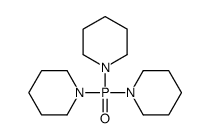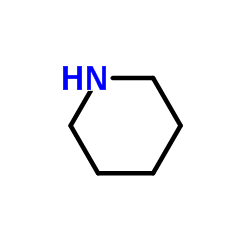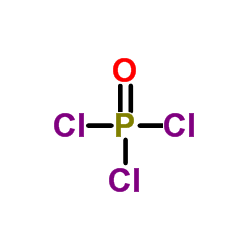4441-17-2
| Name | 1-di(piperidin-1-yl)phosphorylpiperidine |
|---|---|
| Synonyms |
trispiperidinylphosphine oxide
Phosphine oxide,tripiperidino EINECS 224-663-2 1,1',1''-Phosphinoylidynetripiperidine tripiperidinophoshine oxide Piperidine,1,1',1''-phosphinylidynetris tri-1-Piperidinophosphine oxide Tripiperidinophosphine oxide Tripiperidino-phosphinoxid |
| Density | 1.13g/cm3 |
|---|---|
| Boiling Point | 434ºC at 760 mmHg |
| Molecular Formula | C15H30N3OP |
| Molecular Weight | 299.39200 |
| Flash Point | 216.3ºC |
| Exact Mass | 299.21300 |
| PSA | 36.60000 |
| LogP | 3.36590 |
| Index of Refraction | 1.545 |
Synonym: SECTION 2 - COMPOSITION, INFORMATION ON INGREDIENTS
Risk Phrases: 36/37/38 SECTION 3 - HAZARDS IDENTIFICATION EMERGENCY OVERVIEW Appearance: colorless to light yellow. Air sensitive. Target Organs: None. Potential Health Effects The toxicological properties of this material have not been investigated. Use appropriate procedures to prevent opportunities for direct contact with the skin or eyes and to prevent inhalation. SECTION 4 - FIRST AID MEASURES Eyes:
Immediately flush eyes with plenty of water for at least 15 minutes, occasionally lifting the upper and lower eyelids. Skin: Flush skin with plenty of soap and water for at least 15 minutes while removing contaminated clothing and shoes. Ingestion: Do NOT induce vomiting. If conscious and alert, rinse mouth and drink 2-4 cupfuls of milk or water. Inhalation: Remove from exposure to fresh air immediately. Notes to Physician: Treat symptomatically and supportively. SECTION 5 - FIRE FIGHTING MEASURES General Information: As in any fire, wear a self-contained breathing apparatus in pressure-demand, MSHA/NIOSH (approved or equivalent), and full protective gear. During a fire, irritating and highly toxic gases may be generated by thermal decomposition or combustion. Extinguishing Media: In case of fire, use water, dry chemical, chemical foam, or alcohol-resistant foam. SECTION 6 - ACCIDENTAL RELEASE MEASURES General Information: Use proper personal protective equipment as indicated in Section 8. Spills/Leaks: Clean up spills immediately, observing precautions in the Protective Equipment section. Sweep up, then place into a suitable container for disposal. SECTION 7 - HANDLING and STORAGE Handling: Wash thoroughly after handling. Remove contaminated clothing and wash before reuse. Avoid contact with eyes, skin, and clothing. Avoid ingestion and inhalation. Storage: Store in a cool, dry place. Keep container closed when not in use. SECTION 8 - EXPOSURE CONTROLS, PERSONAL PROTECTION Engineering Controls: Use adequate general or local exhaust ventilation to keep airborne concentrations below the permissible exposure limits. Use process enclosure, local exhaust ventilation, or other engineering controls to control airborne levels. Exposure Limits +++++ | Chemical Name | ACGIH | NIOSH |OSHA - Final PELs| ||||| | Tripiperidinophosph|none listed |none listed |none listed | | ine oxide, 98% | | | | +++++ OSHA Vacated PELs: Tripiperidinophosphine oxide, 98%: No OSHA Vacated PELs are listed for this chemical. Personal Protective Equipment Eyes: Wear safety glasses and chemical goggles if splashing is possible. Skin: Wear appropriate protective gloves and clothing to prevent skin exposure. Clothing: Wear appropriate protective clothing to minimize contact with skin. Respirators: Wear a NIOSH/MSHA or European Standard EN 149 approved full-facepiece airline respirator in the positive pressure mode with emergency escape provisions. SECTION 9 - PHYSICAL AND CHEMICAL PROPERTIES Physical State: Not available. Appearance: colorless to light yellow Odor: None reported. pH: Not available. Vapor Pressure: Not available. Viscosity: Not available. Boiling Point: Not available. Freezing/Melting Point: 40.00 - 42.00 deg C Autoignition Temperature: Not available. Flash Point: > 110 deg C (> 230.00 deg F) NFPA Rating: Not published. Explosion Limits, Lower: Not available. Upper: Not available. Decomposition Temperature: Solubility: Specific Gravity/Density: Molecular Formula: C15H30N3OP Molecular Weight: 299.38 SECTION 10 - STABILITY AND REACTIVITY Chemical Stability: Stable under normal temperatures and pressures. Conditions to Avoid: Incompatible materials, strong oxidants. Incompatibilities with Other Materials: Strong oxidizing agents. Hazardous Decomposition Products: Nitrogen oxides, phosphine, carbon monoxide, irritating and toxic fumes and gases, carbon dioxide, nitrogen. Hazardous Polymerization: Has not been reported. SECTION 11 - TOXICOLOGICAL INFORMATION RTECS#: CAS# 4441-17-2: SZ1678000 LD50/LC50: Not available. Carcinogenicity: Tripiperidinophosphine oxide, 98% - Not listed by ACGIH, IARC, NIOSH, NTP, or OSHA. See actual entry in RTECS for complete information. SECTION 12 - ECOLOGICAL INFORMATION SECTION 13 - DISPOSAL CONSIDERATIONS Chemical waste generators must determine whether a discarded chemical is classif as a hazardous waste. US EPA guidelines for the classification determination are listed in 40 CFR Part Additionally, waste generators must consult state and local hazardous waste regu ensure complete and accurate classification. RCRA P-Series: None listed. RCRA U-Series: None listed. SECTION 14 - TRANSPORT INFORMATION CDG/CPL Not classified as hazardous for supply. Canadian TDG No information available. SECTION 15 - REGULATORY INFORMATION European/International Regulations European Labeling in Accordance with EC Directives Hazard Symbols: XI Risk Phrases: R 36/37/38 Irritating to eyes, respiratory system and skin. Safety Phrases: S 24/25 Avoid contact with skin and eyes. WGK (Water Danger/Protection) CAS# 4441-17-2: No information available. United Kingdom Occupational Exposure Limits Canada None of the chemicals in this product are listed on the DSL/NDSL list. WHMIS: Not available. CAS# 4441-17-2 is not listed on Canada's Ingredient Disclosure List. Exposure Limits US FEDERAL TSCA CAS# 4441-17-2 is listed on the TSCA inventory. Health & Safety Reporting List None of the chemicals are on the Health & Safety Reporting List. Chemical Test Rules None of the chemicals in this product are under a Chemical Test Rule. Section 12b None of the chemicals are listed under TSCA Section 12b. TSCA Significant New Use Rule None of the chemicals in this material have a SNUR under TSCA. SARA Section 302 (RQ) None of the chemicals in this material have an RQ. Section 302 (TPQ) None of the chemicals in this product have a TPQ. Section 313 No chemicals are reportable under Section 313. Clean Air Act: This material does not contain any hazardous air pollutants. This material does not contain any Class 1 Ozone depletors. SECTION 16 - ADDITIONAL INFORMATION MSDS Creation Date: 9/02/1997 Revision #1 Date: 8/02/2000 The information above is believed to be accurate and represents the best information currently available to us. However, we make no warranty of merchantability or any other warranty, express or implied, with respect to such information, and we assume no liability resulting from its use. Users should make their own investigations to determine the suitability of the information for their particular purposes. In no way shall the company be liable for any claims, losses, or damages of any third party or for lost profits or any special, indirect, incidental, consequential or exemplary damages, howsoever arising, even if the company has been advised of the possibility of such damages. SECTION 16 - ADDITIONAL INFORMATION N/A |
| HS Code | 2933399090 |
|---|
|
~% 
4441-17-2 |
| Literature: Michaelis; Werner Chemische Berichte, 1895 , vol. 28, p. 1017,2211 Justus Liebigs Annalen der Chemie, 1903 , vol. 326, p. 200 |
|
~% 
4441-17-2 |
| Literature: Michaelis; Werner Chemische Berichte, 1895 , vol. 28, p. 1017,2211 Justus Liebigs Annalen der Chemie, 1903 , vol. 326, p. 200 |
| Precursor 2 | |
|---|---|
| DownStream 0 | |
| HS Code | 2933399090 |
|---|---|
| Summary | 2933399090. other compounds containing an unfused pyridine ring (whether or not hydrogenated) in the structure. VAT:17.0%. Tax rebate rate:13.0%. . MFN tariff:6.5%. General tariff:20.0% |

